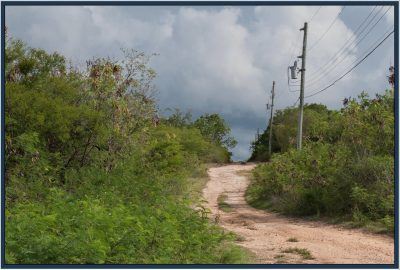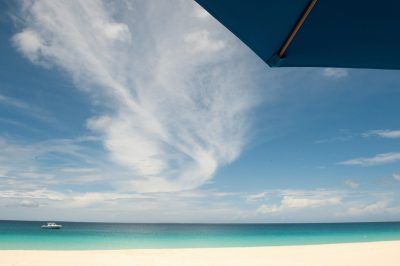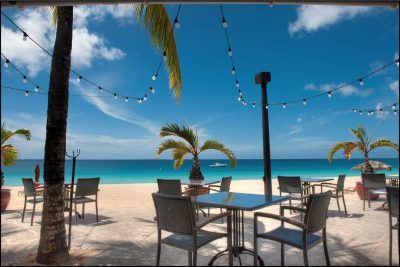by Bill Murray
 Anguilla is a sandbar ten miles long. It’s three miles wide if you’re being generous, but generous isn’t a word that pairs well with the endowments of a small, arid skerry of sand pocked with salt ponds.
Anguilla is a sandbar ten miles long. It’s three miles wide if you’re being generous, but generous isn’t a word that pairs well with the endowments of a small, arid skerry of sand pocked with salt ponds.
A seventeenth century history of the West Indies cursed Anguilla as a place “filled with alligators and other noxious animals.” A hundred years later people still lived “without Government or Religion, having no Minister nor Governor, no Magistrates, no Law, and no Property worth keeping.”
It was too dry, its soil too rocky to meet the requirements of the great sugar plantations, so Anguilla never attracted many white overlords, feudal estates or the vast slave holdings required to tend them. After a time, the few would be plantation barons couldn’t manage to feed what slaves they had, so they gave them most of the week off, three days to tend subsistence plots and Sunday for church.
Who named Anguilla “the eel?” The Spanish may have sailed by under Columbus, though there is no known record. The French definitely called there, but both declined to colonize it, leaving that to the Brits, who found Anguilla unworthy of its own governor. They had it administered from Antigua, then St. Kitts; both applied determined neglect, prompting islanders to petition London to reinstate direct colonial rule in 1872. That request was studiously ignored.
Through a series of ad hoc contrivances (A royal commission, creation then dissolution of a “Leeward Islands Federation”), over the next hundred years the British government tried to placate the Anguillans without expending too much effort.
Rule from St Kitt’s, sixty miles over the horizon, benefitted only the Kittians. (examples: St. Kitts denied the island electricity because it decided the houses were too far apart. The hospital system had only enough funding to transport two emergency patients a year from the island). To citizens of the eel the Brits weren’t the enemy, Kittian cronyism was. Resentment between the islands festered and Anguillans continued to reject the rupture with the British despite the Brits’ general colonial withdrawal.
By 1966 the British had divested themselves of their entire African colonial empire except Namibia. The next year they tried to fashion a new Caribbean colony-shedding federation called the associated state of St-Kitts-Nevis-Anguilla. This was false freedom, from the Anguillans’ perspective, a new, unseemly – and much more proximate – colonial boot on the neck.
The government in St. Kitts decided to celebrate the new federation by selecting a three-island Statehood Queen. Young contestants from St. Kitts and Nevis were brought to Anguilla to stand against the local girls.
Anti-union protests flared. “Federal” police from St. Kitts fired tear gas which drifted over the contest and “dispersed the contestants.” The Kittians had gassed their own beauty contest.
In tune with the tumult of the times, the Anguillans revolted. In May the island threw out the St Kitts police and declared their independence. It began in the predawn of a Monday; a mass assembly of citizens (mass being a relative term in Anguilla) marched on the police station. They rounded up all 17 policemen from St. Kitts, who spent the day hitching rides home, and there it was, Anguilla had a revolution.
 While negotiations ensued, the sand bar raised a 50-person militia to hold off any reinvading Kittians. They organized the first of two referendums seeking to return to the British colonial embrace, and prevailed by 1813 votes to 5. Calling it a Declaration of Independence, they rather pleaded “We stand before the Queen in the greatest humility, with the desire in our hearts to be faithful subjects to her.”
While negotiations ensued, the sand bar raised a 50-person militia to hold off any reinvading Kittians. They organized the first of two referendums seeking to return to the British colonial embrace, and prevailed by 1813 votes to 5. Calling it a Declaration of Independence, they rather pleaded “We stand before the Queen in the greatest humility, with the desire in our hearts to be faithful subjects to her.”
Constitutionally, the Brits were prohibited from interfering in the affairs of the associated state of St-Kitts-Nevis-Anguilla they had created. Wiggle room was found, some months passed and in time London dispatched an envoy named William Whitlock to find an “interim agreement.” The apparently ham-handed diplomat was forced off the island at gunpoint.
“He … patronised those who had turned out to greet him by having his staff distribute leaflets outlining British proposals,” the Caribbean Beat newspaper reported. Whitlock’s private secretary threw them over the crowd, in the words of a local journalist, “as a farmer might throw corn to fowl.”
Before the day was out, Whitlock had fled. The alarmed Premier back in St. Kitts warned the British Government that “gangsters had taken control of Anguilla,” and so began Operation Sheepskin.
In the predawn darkness eight days later, 135 surely sheepish British parachute troops and forty Metropolitan Police officers waded from a frigate onshore at Crocus Bay (there was no dock) to be greeted by about sixty reporters, foreshadowing the 1992 US amphibious landing in Mogadishu that was broadcast live.
Residents turned out to see what was up, wearing all manner of colorful island finery. It was a most unorthodox military operation. Fleet Street’s acidic punditry named Operation Sheepskin after their preferred beast: they dubbed it the Bay of Piglets. A Member of Parliament extended Prime Minister Harold Wilson “congratulations … on at last taking on somebody of his own size.” The operation cost the crown some £600,000.
•••••
After the first World War the Brits installed a hand-cranked phone system on Anguilla. Remarkably, when John Updike and his family lived on Anguilla for five weeks in 1960, they found that the same “lonely generator supplied power to a telephone line serving fourteen users, most of them island officials. There was also a social center at the East End, with electric lights and a juke box,” and there were “scanty crops of cotton and yams and sisal.”
In 1968 V. S. Naipaul declared the entire island “a mistake,” but noted a certain entrepreneurial flair: “the Anguillans (after chasing away an American and his DC-3) had set up three fiercely competitive little airlines of their own, Air Anguilla, Anguilla Airways, Valley Air Services, each with its own livery and its own five-passenger Piper Aztecs regularly doing the five-minute, five-dollar connecting hop from St. Martin.”
 Today Anguilla’s beaches are lined with high-end resorts. Visiting Anguilla from neighboring Sint Maarten, the way most people do, sets up the shortest visit to a country you’ll probably ever have. In my case, between the passport stamp into Sint Maarten’s Princess Juliana Airport and the passport stamp out, around the corner at the Anguilla ferry dock, elapsed time was sixteen minutes. And in Anguilla I managed to find a retired revolutionary.
Today Anguilla’s beaches are lined with high-end resorts. Visiting Anguilla from neighboring Sint Maarten, the way most people do, sets up the shortest visit to a country you’ll probably ever have. In my case, between the passport stamp into Sint Maarten’s Princess Juliana Airport and the passport stamp out, around the corner at the Anguilla ferry dock, elapsed time was sixteen minutes. And in Anguilla I managed to find a retired revolutionary.
The way Stedman, now nearly 70, told the story over coffee with a bit of milk, Anguilla achieved home rule peacefully, but it didn’t come without drama. He spoke softly of his youth, when he read by kerosene lamps.
Once in a while St. Kitts would get a few new cars from England and eventually one or two of their old cars would make it over here to Anguilla. There were no paved roads back then, mostly just the sand and scrub that kept a plantation economy from taking root, so these cars were enormously exciting. His eyes sparkled at the memory.
It was clear all along to Stedman and his cohort that Kittians saw Anguillans as second class. Once Canada donated money to build a pier in Anguilla but the money was used to build it in St. Kitts instead. He said that when the Anguillans stood up to revolt, because he was a young man of around twenty he had no choice. He was a prime revolutionary.
They would demonstrate and they would strike and one tense morning England sailed in that ship full of armed men. This was the “Bay of Piglets.” In short order the Brits assumed positions all over the island.
Stedman’s gentle voice grew a little louder and he rubbed his forehead and twisted his spoon as he told of the island’s most fateful day. Young men of Stedman’s age put down their tools (he worked in construction) all across the island and rallied to form rings around the troops.
In Stedman’s telling, once the Brits heard Anguilla’s demands, which were non-violent, just for dignity and home rule under England and not under St. Kitts, not a shot was fired in anger. The day the agreement was finally signed, December 19th, later became his wedding day. He’s been married for years now to a girl from St. Kitts.
When we met, Stedman had been in his job for three years, working for a resort. His day off was Monday, and naturally, he went to church before work on Sundays. (It looked to me like most of the good folks of Anguilla went to church, or at least enjoyed dressing up in their Sunday best.)
Eventually the Anguillans achieved their aim of reattaching themselves to the British empire. The Anguilla Act of 1971 put the island back under British control and in 1982 Anguilla formally became a dependent territory of the United Kingdom. And besides the growth of tourist resorts and a hurricane or two, not a lot has happened since.
